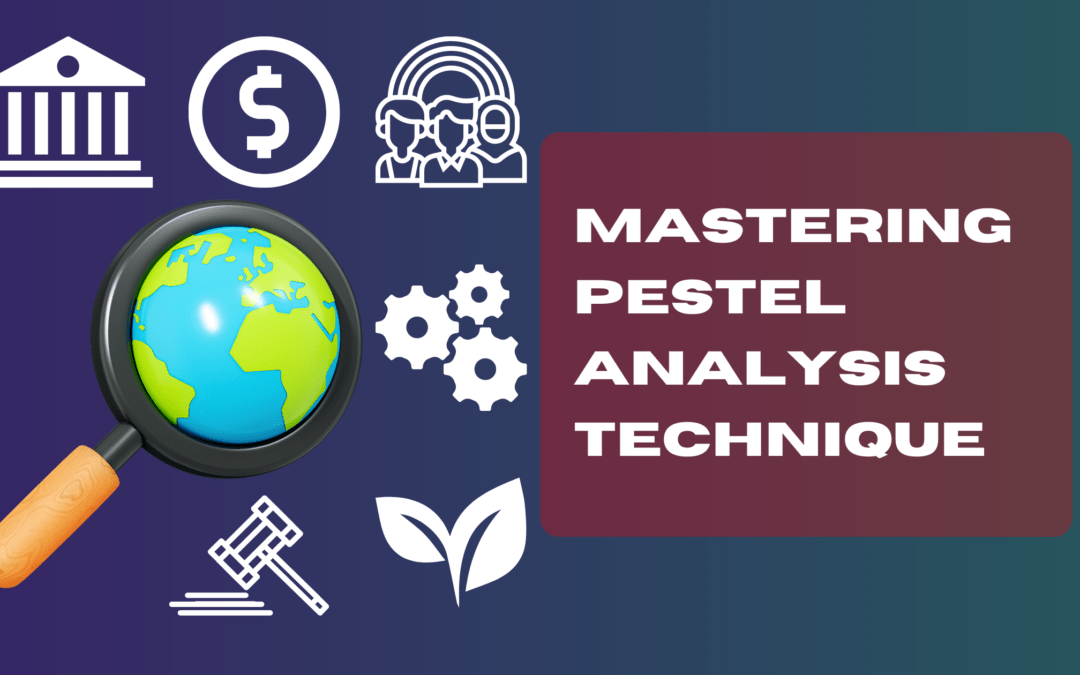PESTEL Analysis Technique: Unveiling Strategic Insights for Business Success
In today’s dynamic business landscape, staying ahead of the competition requires a comprehensive understanding of the factors that influence an organization’s success. One such powerful tool that aids in this endeavor is the PESTEL analysis technique. This technique provides a structured framework to assess the external macro-environmental factors that impact a business. Whether you’re an entrepreneur launching a startup or a seasoned executive navigating a mature market, embracing PESTEL analysis can unlock invaluable insights to drive informed decision-making.
Table of Contents
1. Introduction
In the fast-paced business realm, making well-informed decisions is paramount. PESTEL analysis stands as a guiding light, illuminating the external factors that influence a company’s operations, strategies, and overall success. Let’s dive into this insightful technique and explore its various dimensions.
2. Understanding PESTEL Analysis
PESTEL analysis, an acronym for Political, Economic, Social, Technological, Environmental, and Legal analysis, provides a comprehensive framework for evaluating the external factors that shape an organization’s environment. By scrutinizing these factors, businesses can anticipate potential opportunities and threats, fostering strategic planning and adaptation.
3. Political Factors
The political landscape significantly impacts businesses through policies, regulations, and government stability. Understanding the political climate helps companies foresee changes that might affect their operations, such as taxation policies or trade regulations.
4. Economic Factors
Economic shifts, including inflation, exchange rates, and economic growth, play a pivotal role in business success. Analyzing these factors aids in identifying market trends and potential financial risks.
5. Social Factors
Societal trends, cultural preferences, and demographics influence consumer behavior and demand. By grasping these dynamics, companies can tailor their products and services to resonate with their target audience.
6. Technological Factors
Rapid technological advancements can disrupt industries overnight. PESTEL analysis highlights technological trends, enabling businesses to embrace innovation and stay competitive.
7. Environmental Factors
Environmental consciousness is on the rise, impacting industries’ sustainability efforts and consumer perceptions. Companies that integrate eco-friendly practices can gain a competitive edge.
8. Legal Factors
Legal and regulatory frameworks affect business operations, from intellectual property protection to labor laws. Adhering to these regulations ensures compliance and avoids potential legal pitfalls.
9. Benefits of PESTEL Analysis
PESTEL analysis offers a multitude of benefits, including risk mitigation, strategic planning, and enhanced adaptability. By dissecting the external environment, businesses can proactively respond to challenges and seize opportunities.
10. Applying PESTEL Analysis: A Step-by-Step Guide
1. Identify the Six Factors:
Begin by categorizing the factors – Political, Economic, Social, Technological, Environmental, and Legal.
2. Gather Relevant Data:
Collect data related to each factor, utilizing sources like industry reports, government publications, and market research.
3. Analyze and Prioritize:
Evaluate the impact of each factor on your business. Prioritize those with the most significant influence.
4. Formulate Strategies:
Develop strategies to capitalize on opportunities and mitigate risks identified through analysis.
11. Real-world Examples
Companies like Apple and Tesla have utilized PESTEL analysis to anticipate market shifts and innovate accordingly, showcasing its practical significance.
12. Challenges and Limitations
While powerful, PESTEL analysis has limitations, such as oversimplification of complex issues and the potential omission of micro-level factors.
13. Future Outlook
As the business landscape evolves, so will the relevance of PESTEL analysis. Its adaptability will continue to make it a crucial tool for strategic decision-making.
14. Conclusion
In a world of uncertainty, being equipped with insights is a strategic advantage. PESTEL analysis empowers businesses to navigate the intricacies of their environment, fostering growth, innovation, and resilience.
15. Frequently Asked Questions (FAQs)
1. Is PESTEL analysis only suitable for large corporations?
PESTEL analysis benefits businesses of all sizes, aiding in understanding the external environment’s dynamics.
2. How often should PESTEL analysis be conducted?
Conduct PESTEL analysis periodically, especially during significant market shifts or strategic planning phases.
3. Can PESTEL analysis replace internal assessments?
No, PESTEL analysis complements internal assessments, offering a holistic view of the business landscape.
4. Are all PESTEL factors equally important?
The significance of each factor varies depending on the industry and business context.
5. Where can I learn more about implementing PESTEL analysis effectively?
Link to additional resources here:
In conclusion, PESTEL analysis is a potent compass that guides businesses through the ever-changing tides of the external environment. By embracing its insights, organizations can chart their course towards sustainable success in the competitive business seas.

